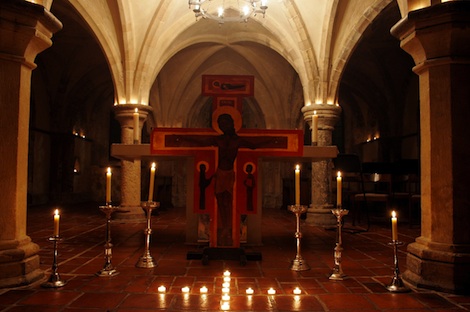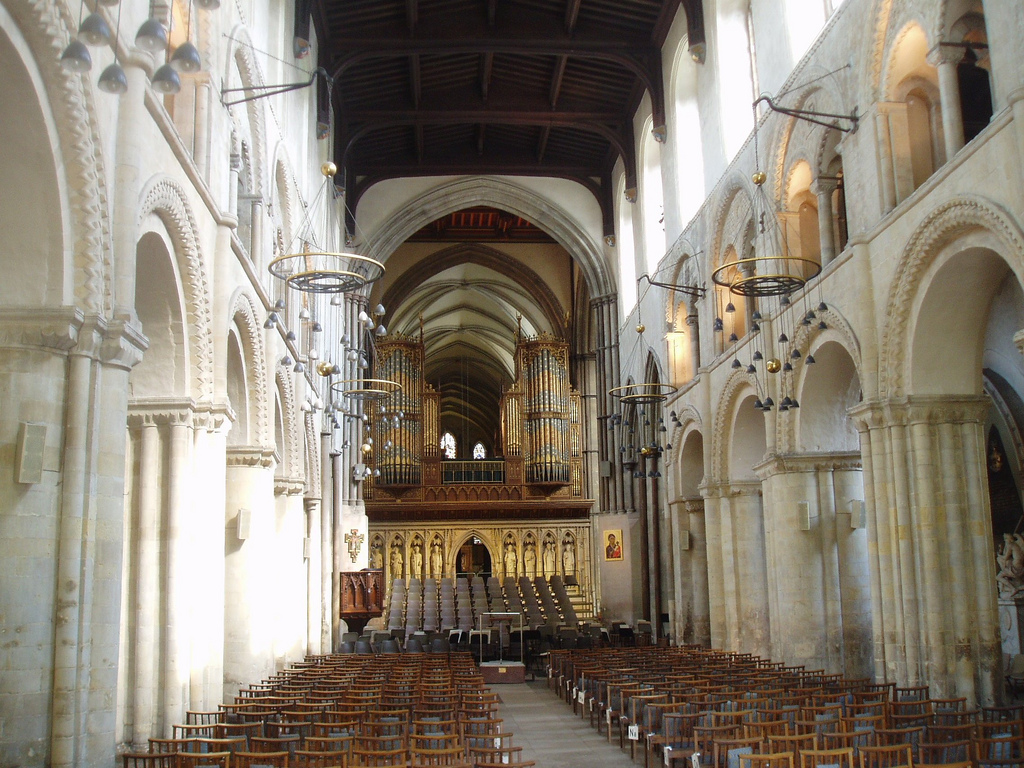Rochester Cathedral, formally the Cathedral Church of Christ and the Blessed Virgin Mary, is an English church of Norman architecture in Rochester, Medway.
The church is the cathedral of the Diocese of Rochester in the Church of England and the seat (cathedra) of the Bishop of Rochester, the second oldest bishopric in England after that of the Archbishop of Canterbury. The edifice is a Grade I listed building (number 1086423).
History
The Rochester diocese was founded by Justus, one of the missionaries who accompanied Augustine of Canterbury to convert the pagan southern English to Christianity in the early 7th century. As the first Bishop of Rochester, Justus was granted permission by King Æthelberht of Kent to establish a church dedicated to Andrew the Apostle (like the monastery at Rome where Augustine and Justus had set out for England) on the site of the present cathedral, which was made the seat of a bishopric. The cathedral was to be served by a college of secular priests and was endowed with land near the city called Priestfields.
Under the Roman system, a bishop was required to establish a school for the training of priests. To provide the upper parts for music in the services a choir school was required. Together these formed the genesis of the cathedral school which today is represented by the King's School, Rochester. The quality of chorister training was praised by Bede.
The original cathedral was 42 feet (13 m) high and 28 feet (8.5 m) wide. The apse is marked in the current cathedral on the floor and sets outside show the line of the walls. Credit for the construction of the building goes to King Ethelbert rather than St Justus. Bede describes St Paulinus' burial as "in the sanctuary of the Blessed Apostle Andrew which King Ethelbert founded likewise he built the city of Rochester."
King Ethelbert died in 617 and his successor, Eadbald of Kent, was not a Christian. Justus fled to Francia and remained there for a year before he was recalled by the king.
In 644 Ithamar, the first English-born bishop, was consecrated at the cathedral. Ithamar consecrated Deusdedit as the first Saxon Archbishop of Canterbury on 26 March 655.
The cathedral suffered much from the ravaging of Kent by King Aethelred of Mercia in 676. So great was the damage that Bishop Putta retired from the diocese and his appointed successor, Cwichelm, gave up the see "because of its poverty".
In 762, the local overlord, Sigerd, granted land to the bishop, as did his successor Egbert. The charter is notable as it is confirmed by Offa of Mercia as overlord of the local kingdom.
Following the invasion of 1066, William the Conqueror granted the cathedral and its estates to his half-brother, Odo of Bayeux. Bishop Odo misappropriated the resources and reduced the cathedral to near-destitution. The building itself was ancient and decayed. During the episcopate of Siward (1058–1075) it was served by four or five canons "living in squalour and poverty". One of the canons became vicar of Chatham and raised sufficient money to make a gift to the cathedral for the soul and burial of his wife, Godgifu.
Architecture
The original Lady Chapel was formed in the south transept by screening it off from the crossing. The altar of the Blessed Virgin Mary was housed in the eastern arch of the transept. There are traces of painting both on the east wall and under the arch. The painting delineates the location of the mediaeval north screen of the Lady Chapel. Around 1490 this chapel was extended westwards by piercing the western wall with a large arch and building the chapel's nave against the existing south aisle of cathedral. From within the Lady Chapel the upper parts of two smaller clerestory windows may be seen above the chapel's chancel arch. Subsequently a screen was placed under the arch and the modern Lady Chapel formed in the 1490 extension.
The south transept is of early Decorated style. The eastern wall of it is a single wide arch at the arcade level. There are two doorways in the arch, neither of which is used, the northern one being hidden by the memorial to Dr William Franklin. The south wall starts plain but part way up is a notable monument to Richard Watts, a "coloured bust, with long gray beard". According to Palmer there used to be a brass plaque to Charles Dickens below this but only the outline exists, the plaque having been moved to the east wall of the choir transept. The west wall is filled by the large arch mentioned above with the screen below dividing it from the present Lady Chapel.
The Lady Chapel as it now exists is of Decorated style with three lights along southern wall and two in the west wall. The style is a light and airy counterpart to the stolid Norman work of the nave. The altar has been placed against the southern wall resulting in a chapel where the congregation wraps around the altar. The window stained glass is modern and tells the gospel story.
The first, easternmost, window has the Annunciation in the upper light: Gabriel speaking to Mary (both crowned) with the Holy Spirit as a dove descending. The lower light shows the Nativity with the Holy Family, three angels and shepherds. The next window shows St Elizabeth in the upper light surrounded by stars and the sun in splendour device. The lower light shows the Adoration of the Magi with Mary enthroned with the Infant. The final window of the south wall has St Mary Magdelene with her ointment surrounded by Tudor roses and fleurs-de-lis in the upper light with the lower light showing the Presentation in the Temple. The west wall continues with St. Margaret of Scotland in the upper light surrounded by fouled anchor and thistle roundels. The reference is to the original dedication of the cathedral as the Priory of St Andrew. The lower light shows the Crucifixion with Mary and St Peter. The final window is unusual, the upper light is divided in three and shows King Arthur with the royal arms flanked by St George on the left and St Michael on the right. The lower light shows the Ascension: two disciples to the left, three women with unguents to the right and three bare crosses top right.











